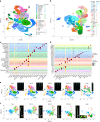Time series single-cell transcriptional atlases reveal cell fate differentiation driven by light in Arabidopsis seedlings
- PMID: 37903986
- PMCID: PMC10724060
- DOI: 10.1038/s41477-023-01544-4
Time series single-cell transcriptional atlases reveal cell fate differentiation driven by light in Arabidopsis seedlings
Abstract
Light serves as the energy source for plants as well as a signal for growth and development during their whole life cycle. Seedling de-etiolation is the most dramatic manifestation of light-regulated plant development processes, as massive reprogramming of the plant transcriptome occurs at this time. Although several studies have reported about organ-specific development and expression induced by light, a systematic analysis of cell-type-specific differentiation and the associated transcriptional regulation is still lacking. Here we obtained single-cell transcriptional atlases for etiolated, de-etiolating and light-grown Arabidopsis thaliana seedlings. Informative cells from shoot and root tissues were grouped into 48 different cell clusters and finely annotated using multiple markers. With the determination of comprehensive developmental trajectories, we demonstrate light modulation of cell fate determination during guard cell specialization and vasculature development. Comparison of expression atlases between wild type and the pifq mutant indicates that phytochrome-interacting factors (PIFs) are involved in distinct developmental processes in endodermal and stomatal lineage cells via controlling cell-type-specific expression of target genes. These results provide information concerning the light signalling networks at the cell-type resolution, improving our understanding of how light regulates plant development at the cell-type and genome-wide levels. The obtained information could serve as a valuable resource for comprehensively investigating the molecular mechanism of cell development and differentiation in response to light.
© 2023. The Author(s).
Conflict of interest statement
The authors declare no competing interests.
Figures






Similar articles
-
The Transcription Factors TCP4 and PIF3 Antagonistically Regulate Organ-Specific Light Induction of SAUR Genes to Modulate Cotyledon Opening during De-Etiolation in Arabidopsis.Plant Cell. 2019 May;31(5):1155-1170. doi: 10.1105/tpc.18.00803. Epub 2019 Mar 25. Plant Cell. 2019. PMID: 30914467 Free PMC article.
-
Regulation of Sugar and Storage Oil Metabolism by Phytochrome during De-etiolation.Plant Physiol. 2020 Feb;182(2):1114-1129. doi: 10.1104/pp.19.00535. Epub 2019 Nov 20. Plant Physiol. 2020. PMID: 31748417 Free PMC article.
-
Glucose status within dark-grown etiolated cotyledons determines seedling de-etiolation upon light irradiation.Plant Physiol. 2023 Dec 30;194(1):391-407. doi: 10.1093/plphys/kiad508. Plant Physiol. 2023. PMID: 37738410
-
PIFs: systems integrators in plant development.Plant Cell. 2014 Jan;26(1):56-78. doi: 10.1105/tpc.113.120857. Epub 2014 Jan 30. Plant Cell. 2014. PMID: 24481072 Free PMC article. Review.
-
Functions of Phytochrome-Interacting Factors (PIFs) in the regulation of plant growth and development: A comprehensive review.Int J Biol Macromol. 2023 Jul 31;244:125234. doi: 10.1016/j.ijbiomac.2023.125234. Epub 2023 Jun 7. Int J Biol Macromol. 2023. PMID: 37290549 Review.
Cited by
-
snRNA-Seq Unveils Cell-Type-Specific Immune Dynamics in Arabidopsis During Pinewood Nematode Infection.Mol Plant Pathol. 2025 Aug;26(8):e70136. doi: 10.1111/mpp.70136. Mol Plant Pathol. 2025. PMID: 40826955 Free PMC article.
-
48-Hour and 24-Hour Time-lapse Single-nucleus Transcriptomics Reveal Cell-type specific Circadian Rhythms in Arabidopsis.Nat Commun. 2025 May 5;16(1):4171. doi: 10.1038/s41467-025-59424-8. Nat Commun. 2025. PMID: 40324996 Free PMC article.
-
Single-cell omics in plant biology: mechanistic insights and applications for crop improvement.Adv Biotechnol (Singap). 2025 Jul 2;3(3):20. doi: 10.1007/s44307-025-00074-8. Adv Biotechnol (Singap). 2025. PMID: 40593253 Free PMC article. Review.
-
Spatiotemporal bifurcation of HY5-mediated blue-light signaling regulates wood development during secondary growth.Proc Natl Acad Sci U S A. 2024 Dec 3;121(49):e2407524121. doi: 10.1073/pnas.2407524121. Epub 2024 Nov 25. Proc Natl Acad Sci U S A. 2024. PMID: 39585973 Free PMC article.
-
The promising role of proteomes and metabolomes in defining the single-cell landscapes of plants.New Phytol. 2025 Feb;245(3):945-948. doi: 10.1111/nph.20303. Epub 2024 Dec 4. New Phytol. 2025. PMID: 39632263 Free PMC article. Review.
References
-
- Von Arnim A, Deng XW. Light control of seedling development. Annu. Rev. Plant Physiol. Plant Mol. Biol. 1996;47:215–243. - PubMed
-
- Chory J, Peto C, Feinbaum R, Pratt L, Ausubel F. Arabidopsis thaliana mutant that develops as a light-grown plant in the absence of light. Cell. 1989;58:991–999. - PubMed
Publication types
MeSH terms
Substances
LinkOut - more resources
Full Text Sources

